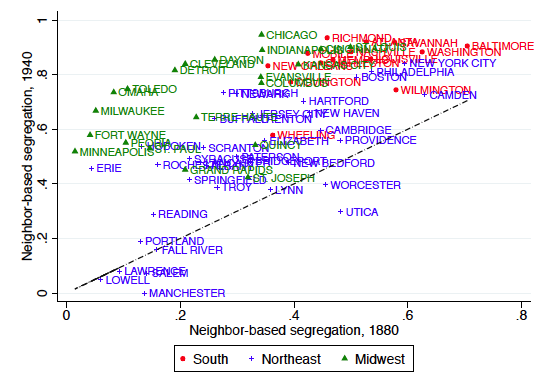Over at the Chicago Reader, Steve Bogira and Mick Dumke have been inserting what they call "the city's most fundamental problem" into the mayoral race, though it hasn't gained traction on the campaign trail: segregation. (Four of the five candidates, all but Emanuel, responded to their request for interviews on the subject, though only Willie Wilson Dock Wallswas particularly specific on solutions.)
Around this time, the Washington Post's Emily Badger called to attention a fascinating new study that demonstrates how entrenched residential segregation is, and also calls into question some historical assumptions about how and where it developed and spread. Well, everywhere except Chicago, which remains an astonishing anomaly.
The authors of the working paper, Trevon Logan of Ohio State and John Parman of William & Mary, took a difficult and novel approach to mapping residential segregation—using census data to identify "neighbor-based" segregation. Not neighborhood-based, neighbor-based: "a measure of segregation based upon the racial similarity of next-door neighbors."
It's pretty cool. And it allows them to challenge what they describe as the received wisdom of the history of residential segregation in America:
The traditional narrative of segregation in the United States supposes that migration of African Americans from the rural South to urban communities, especially in the North, gave rise to segregated cities that persist to this day. Missing from this narrative is any analysis of the national trend in segregation. If segregation was equally likely to exist in rural communities as in urban ones, the focus on urban segregation has told a partial story about segregation in the United States.
And what they find is that—on the whole—southern cities begin (in 1880) as being more segregated than northern cities, and also end (in 1940) as more segregated. Southern cities are much more integrated by ward or district, boundaries that may or may not be drawn around race for a variety of reasons, but on the street level, as experienced by residents, they're actually very segregated. Depending on when or where you're from, this might seem obvious; but at the level of data and history, it's pretty novel.
It does challenge the frequently held belief that the North is more residentially segregated than the South. Except for one city.

Southern cities, by this measure, are pretty similar (and Wilmington and Wheeling are not the most Southern of cities), clustering as moderately to highly segregated in both 1880 and 1940. Northeastern cities are all over the place.
Midwestern cities, on the other hand, are more likely to increase in segregation. And the sole city to top all Southern cities in 1940—including the capital of the Confederacy—is Chicago.
While looking up supporting information, I came across another interesting slicing of the data, from the University of Milwaukee and addressing Milwaukee's segregation. As you might be aware, the Milwaukee area is a politically and racially divided one that compares to Chicago in unfortunate ways. And this research is also intended to question established ways of measuring segregation, concluding that, at the block level, Milwaukee is not as segregated as it's perceived.
But Chicago's data holds no surprises. Of Chicago's black population, as of 2000, 68.5 percent lived on blocks that were at least 80 percent black. That's higher than Gary (if only by 0.2 percentage points), Birmingham (ditto), Memphis, and Cleveland—higher than any metro measured except for Detroit (75 percent).
The reasons for this are many, if not definite. The legal and economic mechanisms for residential segregation were, if not invented in Chicago, at least perfected in and disseminated from the city, a process that coincided with the Great Migration. Bogira and Nikole Hannah-Jones have some ideas for rolling it back, which are echoed a bit in Chuy Garcia's response to their questions; Ben Joravsky and Mick Dumke have more. And they all center around housing policy—which wasn't much of an issue among aldermanic candidates, either—where the seeds of the problem were sown.



